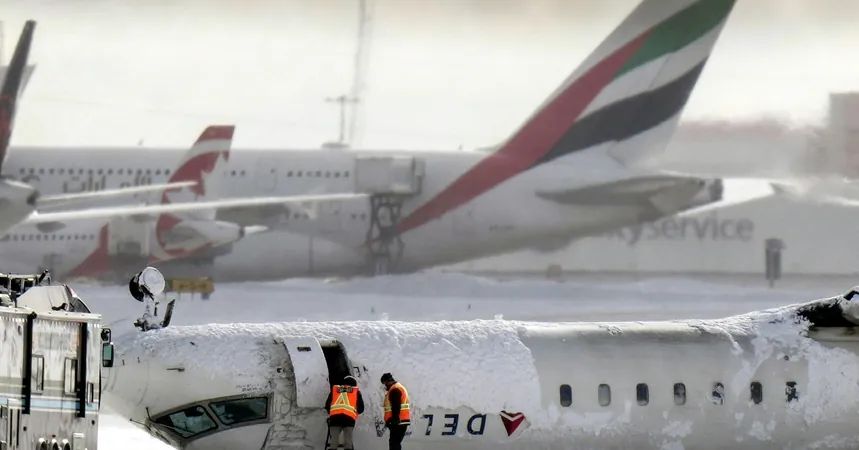
Shocking Details Emerge: Moment-by-Moment Account of February's Delta Crash in Toronto
2025-03-20
Author: Wai
Chilling Insights from the Preliminary Report
In a remarkable preliminary report shared by the Canadian Transportation Safety Board on March 20, chilling insights have emerged from the harrowing Delta Flight 4819 accident in Toronto. The report reveals a detailed, moment-to-moment account of the catastrophic landing that resulted in a terrifying sequence of events.
The Descent and Impact
As the aircraft descended, its enhanced ground proximity warning system—designed specifically to alert pilots to potential hazards during landing—signaled a high descent rate just shy of three seconds before it was supposed to touch down. In fact, less than one second before impact, the plane's instruments showed an airspeed of 134 knots with a bank angle of 7.1 degrees to the right and a nose-up pitch of 1 degree. The descent rate at that critical moment soared to a staggering 1,110 feet per minute.
Catastrophic Chain Reaction
Upon making contact with the runway, the plane banked further to the right, at 7.5 degrees, when disaster struck. A critical component known as a "side-stay," connected to the plane's right landing gear, fractured and retracted violently, setting off a catastrophic chain reaction. The aircraft went into a devastating slide along Runway 23, rolling right side up before flipping completely upside-down, severing a significant portion of the tail in the process.
The Aftermath
In a further stroke of horror, the aircraft slid off the runway and through a snow-covered grass median, ultimately coming to a standstill, inverted, on Runway 15L. Astonishingly, the right wing and landing gear sheared off from the fuselage and were found more than 200 feet away down Runway 23.
Inside the Wreckage
Inside the aircraft, things were equally grim. Passengers and crew members found themselves hanging upside-down, restrained by their seat belts. The chaos of the crash led to some injuries occurring when individuals attempted to release their seat belts in a desperate attempt to escape the burning wreckage. Fortunately, investigators reported no failures of the seat belts themselves.
Challenges in Evacuation
The evacuation process was fraught with challenges; the damage sustained by the aircraft obstructed the flight deck door, effectively trapping the pilots inside. Faced with this dangerous situation, they were forced to use the escape hatch located on the ceiling of the cockpit. Incidentally, the hatch's proximity to the ground hindered their quick exit, but with the assistance of a brave passenger, they managed to escape safely.
A Grim Reminder
This heart-stopping incident underscores the inherent dangers of aviation and serves as a grim reminder of the importance of stringent safety regulations and protocols. As investigations continue, the aviation community watches closely to glean insights and implement changes to prevent such incidents in the future. Stay tuned for more updates as this story develops!


 Brasil (PT)
Brasil (PT)
 Canada (EN)
Canada (EN)
 Chile (ES)
Chile (ES)
 Česko (CS)
Česko (CS)
 대한민국 (KO)
대한민국 (KO)
 España (ES)
España (ES)
 France (FR)
France (FR)
 Hong Kong (EN)
Hong Kong (EN)
 Italia (IT)
Italia (IT)
 日本 (JA)
日本 (JA)
 Magyarország (HU)
Magyarország (HU)
 Norge (NO)
Norge (NO)
 Polska (PL)
Polska (PL)
 Schweiz (DE)
Schweiz (DE)
 Singapore (EN)
Singapore (EN)
 Sverige (SV)
Sverige (SV)
 Suomi (FI)
Suomi (FI)
 Türkiye (TR)
Türkiye (TR)
 الإمارات العربية المتحدة (AR)
الإمارات العربية المتحدة (AR)